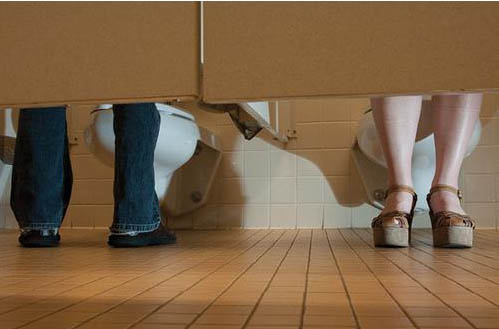Sex, Gender and Restrooms
In the wake of courts striking down laws prohibiting marriage equality, the hatemongers are now pushing for laws in at least 20 states that would require people to use the restroom consistent with their sex or gender. Hatemongers, most of the general public and many judges do not know the difference between sex and gender. So even if the law specifies “gender,” it probably will be interpreted to mean sex. If a judge actually uses the definition of gender as a presentation indicating a gender category, then they would have to make a case-by-case judgment as to whether presentation looks masculine or feminine.
 These laws are addressing the non-existent problem of transgender people using restrooms to perpetrate violence against those in restrooms. It must be emphasized that there has never been a documented case of such violence anywhere in the United States although there are numerous cases of transgender people being attacked.
These laws are addressing the non-existent problem of transgender people using restrooms to perpetrate violence against those in restrooms. It must be emphasized that there has never been a documented case of such violence anywhere in the United States although there are numerous cases of transgender people being attacked.
This brings up the issue of what criteria have been used to categorize people as male or female? And are these criteria practical?
The best scientific answer comes from the science of biology. In this science, males are typically recognized as those animals with small gametes and females as those with larger gametes. Gametes are the cells that fuse together during fertilization. Some humans never produce gametes. After gonadectomy, performed for various medical reasons, both males and females do not then produce gametes at all. After prolonged transsexual hormone therapy, those who used to produce gametes no longer do so. No one wants to be tested in order to carry around papers indicating that they once produced or are now producing large or small gametes and so this criteria may be accurate but not practical.
Historically, the first criterion used was to simply look at external genitalia at birth and compare them with cultural notions of what each sex should look like. This is the criterion that doctors generally use to fill out birth certificates. The problem with this criterion, as our intersex friends with differences in sexual development (DSD) will tell you is that somewhere between 1 and 4% of live births have indeterminate sex using this method. The exact percentage depends on which DSD one includes.
Likewise, inspection of adult genitalia is inaccurate and would be considered an invasion of privacy. Not many people would want to show their genitals so that they can use a particular restroom and who would want a policeman or a judge to make this judgment. The other problem with this criterion is that intersex and transsexual genital plastic surgeries can now alter external genitalia to resemble culture’s idea of what male and female genitalia should look like. So there are many people for whom this criterion is inaccurate.
With the discovery of X and Y sex chromosomes, the next historical criterion used was to count “Barr bodies.” This was a used by the Olympics as a primitive chemical way of counting X chromosomes. The number of Barr bodies was one less than the number of X chromosomes. Females should have two X sex chromosomes resulting in one Barr body and males an X and Y resulting in no Barr bodies. As knowledge of chromosomes improved this method of sex determination was shown to be inaccurate. What about males with XXY or XXXY chromosomes (Kleinfelter’s syndrome)? All kinds of combinations of X and Y chromosomes have been found including people with two types of chromosome configurations having XY in some parts of their bodies and XX in others (mosaics). So this method was discarded by the Olympics.
Most people have never had their chromosomes analyzed, so it is entirely possible for their “chromosome” sex to differ from their natal sex determined by a doctor looking at genitalia. The technical term for the result of chromosome analysis is a report called a karyotype that shows the number and length of chromosomes. Not many people know or have documentation of their karyotype and getting a karyotype costs $1500-2000. So using the karyotype criterion is both inaccurate and impractical.
Historically, the next method that was used for sex determination was the presence or absence of the SRY gene on the Y chromosome that triggers male body development. This method was shown to be inconclusive because the SRY, like other genes, jumps all around the chromosomes. As with karyotypes the test for SRY is expensive and using it as a sex identification criterion impractical.
The Olympics claims that it no longer administers sex tests. But the current procedure clearly amounts to a test by jury. Anyone with suspect sex is examined by a panel of doctors in endocrinology and other specialties but these panels often cannot agree. Recently, these panels have relied on measurement of blood testosterone levels. Some competitors with genetic variations have been shown through no fault of their own to naturally produce higher levels of testosterone than the normal range. Should they be required to have unnecessary surgeries or take blocking hormones to compete? And then there are those who otherwise appear to be male but who have lower than the normal range of testosterone, such as in Kleinfelter’s syndrome. (MTF transsexuals are now allowed to compete as long as they have undergone hormone therapy for at least two years but they must go through the panel procedure.) It would be impractical to require people to carry around a report of a recent testosterone test.
So what is a poor policeman or judge to do to decide if a person is breaking the law?
Police should clearly ignore any such law and not get into the business of policing bathrooms unless violence or an emergency exists. Judges should strike down such laws because if it is very difficult for a medical panel to determine sex then it is beyond the scientific expertise of most judges to determine sex.
What do you think about the idea of testing people before they can pee? Use the comment area below. You must be logged in to comment.
Category: Legal, Transgender Body & Soul, Transgender Opinion





